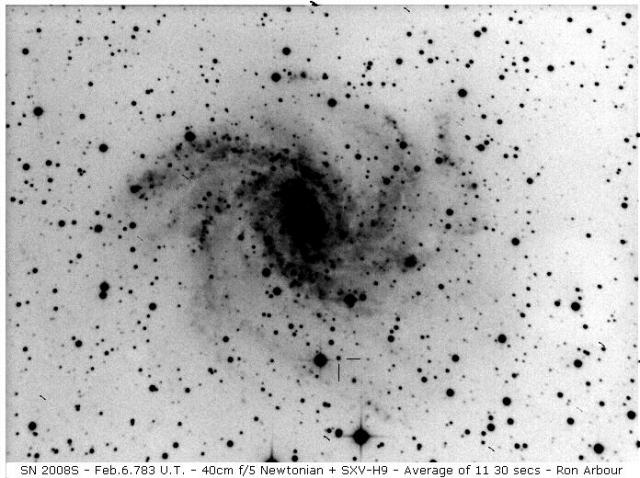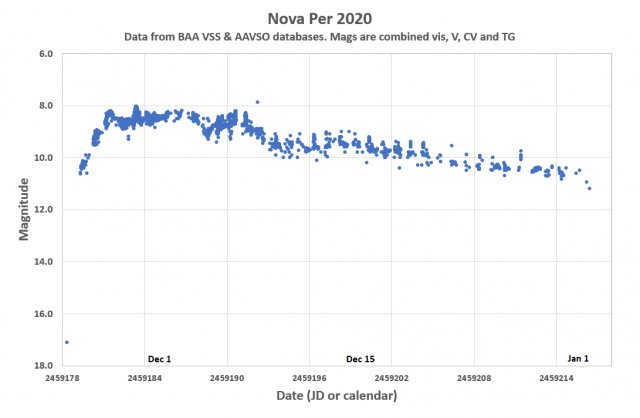Forum Replies Created
-
AuthorPosts
-
 Jeremy ShearsParticipant
Jeremy ShearsParticipantRobin makes an important point here about alert systems. There are many such available.
One that might be of interest to BAA Members is the BAA VSS Alert Group. You can find out how to sign up here.
The aims of the group are to distribute information on variable vtar activity currently observed by BAA VSS members. The Nova discovery was announced there.
Hope you get some more clear sky, Robin!
 Jeremy ShearsParticipant
Jeremy ShearsParticipantHello Mike,
im also happy to have a look if you send me your S/sheet, one of your FITS files and, if possible, a screenshot from AIP4WIN showing the variable and comparisons apertures marked.
The other thing you can do whilst learning is to compare your results with others in the databases. I have not looked up this star so I don’t know whether there are data, otherwise you can also try another star for which there are data
Go well!
Jeremy Jeremy ShearsParticipant
Jeremy ShearsParticipantThanks Tony. I’ve not had any problems since using the hub, so I will let sleeping dogs lie
 Jeremy ShearsParticipant
Jeremy ShearsParticipantRon Arbour has asked me to post this message in his behalf:
The object AT2021 recently discovered in NGC 4631 has been classified as a Luminous Red Variable which is a sub group of Intermediate Luminosity Optical Transients. This group included Intermediate Luminosity Red Transients and intermediate Red Novae among others and bridged the gap between Novae and Supernovae. The first discovery and hence archetype of all these objects was discovered by an amateur and member of the Association, namely myself. A paper on the object was published in the Journal.
J.Br.Astron.Assoc. 126, 3, 2016
 Jeremy ShearsParticipant
Jeremy ShearsParticipantFurther doubt cast on the ALMA detection of phosphine in Venus’s atmosphere: “Complications in the ALMA Detection of Phosphine at Venus”
26 January 2021 at 9:16 am in reply to: Webinar: Peranso 3 Light curve Analysis Software – Live Showcase #583746 Jeremy ShearsParticipant
Jeremy ShearsParticipantI’ve just heard from Tonny Vanmunster that both a recording of the webinar and the PowerPoint slides used can be accessed from the Peranso website.
Highly recommended.
23 January 2021 at 8:53 pm in reply to: Webinar: Peranso 3 Light curve Analysis Software – Live Showcase #583741 Jeremy ShearsParticipant
Jeremy ShearsParticipantYes the webinar was very good, Lars. I’m pretty impressed with Peranso 3. I’m looking forward to the forthcoming updates with the extra functionality that Tonny was demonstratino.
Not sure if it was recorded. I see a couple of folks have asked Tonny, but not seen his reply yet
 Jeremy ShearsParticipant
Jeremy ShearsParticipantYes you can download all the data from both databases. There is a link to the VSS db under “observations” at the top right of this page.
There is an updated light curve on the VSS website: https://britastro.org/vss/
Your dara show just how active this nova is!
 Jeremy ShearsParticipant
Jeremy ShearsParticipantGraeme,
you are welcome to write a note or article containing ToM’s for the VSS Circular. Or you can send ToM measurements directly to Des Loughney and he will include in the Eclipsing Binary News section. The VSSC is sent to Krakow.
Jeremy
 Jeremy ShearsParticipant
Jeremy ShearsParticipantGood fun, James. I enjoyed that.
 Jeremy ShearsParticipant
Jeremy ShearsParticipantHello Tony,
I am not an EB observer so I haven’t used that database. You could drop a line to Des Loughney, VSS EB officer (contact details in the VSS Circular) to see if he knows.
Jeremy
 Jeremy ShearsParticipant
Jeremy ShearsParticipantThere’s a Forum thread here Tracey: https://britastro.org/node/10166
 Jeremy ShearsParticipant
Jeremy ShearsParticipantJan 9.771 Mag 15.7 C
looks like a new outburst
 Jeremy ShearsParticipant
Jeremy ShearsParticipantI’ve just imaged IX Dra from my home obsy: mag 17.4C at 17.24 UT
 Jeremy ShearsParticipant
Jeremy ShearsParticipantWas this also with your 80mm frac, Graeme? Really shows what’s possible with a small scope plus CCD.
 Jeremy ShearsParticipant
Jeremy ShearsParticipantI wouldn’t worry too much Darren. For photometry try what you have at hand first before shelling out on more stuff. If you want to go to the nth degree in photometry you can try something else later. If it helps, I generally run my CCD camera 2 x 2 binned for photometry. There is nothing inherently wrong with binning.
 Jeremy ShearsParticipant
Jeremy ShearsParticipantThanks Graeme. That is helpful. Try on other evenings if you can.
 Jeremy ShearsParticipant
Jeremy ShearsParticipantI just updated the LC with data up to 2021 Jan 2. The last data points hint that might be beginning to fade a bit faster. Keep watching!
When making this plot, I was struck by the undulations in the LC at ~daily intervals. I’ve not looked into whether these are artefacts or genuine.

 Jeremy ShearsParticipant
Jeremy ShearsParticipantA quick reminder that we are only a few days away from the next superoutburst of IX Dra (perhaps 3 to 7 days). Hence observations are encouraged.
I had it at mag 17.1 last night (NY Eve) – just declined from the last “normal” outburst”. The next outburst could well be the super…keep watching!
 Jeremy ShearsParticipant
Jeremy ShearsParticipantNice work Hugh.
There is also a paper by Mark Kidger on Betelgeuse in the December Journal.
The original Betelgeuse Forum thread you mentioned is here.
-
AuthorPosts
